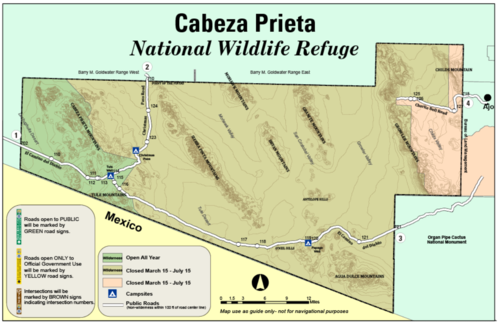
Overland Tech and Travel
Advice from the world's
most experienced overlanders
tests, reviews, opinion, and more
Happy Hour with National Luna
Look closely at the photo above. Aside from the obvious bit of magic we now blithely accept as normal—I’m downloading and viewing photographs in the middle of the Simpson Desert—note the cocktail. It’s a refreshing warm-weather concoction called a dark’n stormy: dark rum, lime juice, simple syrup, and ginger beer, served over ice.
Wait a minute. Ice cubes, six days from Anywhere, Australia? Yes, thanks to the National Luna 50 Twin Weekender fridge/freezer we had along.
Just as with digital photography and laptop computers, we now take for granted the sorcery of the Engel 12V fridge and its descendants, which forever eliminated that three-days-out semi-cool swill in the bottoms of our old Coleman coolers (note I’m referring to proper fridges employing proper compressors, not the ineffective thermoelectric coolboxes). I don’t predict ice chests will go the way of 35mm film and typewriters any time soon—a fridge is still a wince-inducing investment—but increasingly an Engel/ARB/Dometic/Waeco etc. is becoming one of the first accessories added to a new overlanding vehicle. (When we were stopped at state border agricultural checkpoints in Australia, the officers automatically said, “Need to check your fridge.” They assumed anyone in a Land Cruiser had one.)
Recently National Luna upped the ante, and gave us fridges with a separate freezer compartment. No longer do we have to struggle along with just cold beer, milk, and cheese; now we can add to that frozen meats, ice cream—and the means to keep a cocktail properly chilled. (Of course 12V fridges have always had the ability to freeze, but you had to choose one function or the other—fridge or freezer—or bring two units. We’ve done that on group safaris but it’s a bit much for a single vehicle.)
There are several quality brands of 12VDC/120VAC fridges on the market. We’ve had both an Engel and an ARB for years, and each has performed perfectly. With the exception of Engel, which has stuck with their tried and true Sawafuji swing motor compressor, and Waeco, which uses a branded compressor, virtually all fridge makers use the identical SECOP BD35 compressor in their smaller units, and the SECOP BD50 for larger fridges. (These were formerly known as Danfoss, but that company was bought out in 2010.)
Since the compressor is the heart of the fridge, you might think there wouldn’t be much difference in performance between brands using the same one, and continue to wonder why there is such a price disparity between those brands. Indeed, in general all work well and are reliable in harsh conditions. But the thickness and quality of insulation has an obvious impact on how often the compressor has to cycle (and thus use power) to maintain a set temperature, as does, to a lesser extent, the lid seal. Also, the thermostat can simply turn the compressor on or off, or the manufacturer can incorporate a sophisticated electronic control that varies the output in response to several parameters, further conserving energy. Inexpensive fridges use plastic exterior and interior cladding; more expensive models use aluminum or even stainless steel. In some fridges the evaporator plate is exposed in the interior, where it is susceptible to damage; in others it’s enclosed. Some fridges use plastic latches, others stainless steel.
Finally there are the ergonomic factors. Does the lid open only one way, or can it be switched to hinge sideways? Is there a useful interior light? Is the interior simply one big space, or are there baskets for organizing and securing contents? Does the control panel have an actual thermometer, or just a dial with numbers? What about a voltage monitor and adjustable low-voltage cutout? And since I’ve already written “finally,” a postscript that might or might not be important to you: You’ve spent a lot of money—does the fridge look like it’s worth it?
National Luna justifies its premium pricing by handily checking off all these factors. Particularly in the category of performance, in the fridge comparison tests in which I’ve been involved it consistently manages to both cool contents the quickest and keep them that way while using less power overall—an impressive trick. In fact, the one beef I have with this fridge is the name: “Weekender?” Not sure what NL was thinking, because the 50 Twin combines a 40-liter fridge with a 10-liter freezer—enough capacity for a far longer trip than one weekend. Not only is the capacity generous, but an easy-to-miss additional advantage of fridges over ice chests is that you don’t have to load all the contents at the beginning of the trip; the fridge will easily chill stuff added en route. We had more than enough room for all our refrigerated goods for ten days between supply sources.
And the ice cubes just kept coming, every evening . . .
The NL fridge temporarily lashed down next to the Kanz kitchen. The fridge will be moved to a permanent position at the back of the Troopy once we have the cabinetry installed.
2015 Continental Divide vehicle report
Last year, the 1600 miles of the RawHyde/Exploring Overland Continental Divide trip proved to be a challenge for the participating vehicles (report here). This year’s journey proved just as challenging, in different ways. In no particular order the nine vehicles along this time were:
- 2008 Ford F350 6.4 diesel double-cab pickup
- 2012 Toyota Tacoma 4.0 V6 with Four Wheel Camper (our JATAC)
- 2010 Toyota Tacoma double-cab 4.0 V6 supercharged, with canvas bed shell
- 2014 Ram Power Wagon double-cab with Four Wheel Camper
- Ford Raptor with Four Wheel Camper
- 2014 Ford Raptor with Northstar camper
- 2009 Sportsmobile on a Ford 6.0 diesel chassis
- Toyota Tundra with fiberglass shell and roof tent
- 2008 Toyota Land Cruiser 200-Series with roof tent
For the first couple of days we seemed to be getting off lightly—the worst issue to surface was a burned out turn signal bulb in the aftermarket headlamp assembly on Ross Blair’s Tacoma. But somewhere north of Grants, New Mexico, Michael and Darla’s Raptor/FWC combination blew the Firestone air bag on the right rear spring on a long off-pavement section, causing the bag’s internal bump stops to slam against each other over the mildest terrain. Inspection revealed that the air bag was the longer of the two offered for the Raptor by Firestone—probably a mistake with a camper mounted. It appeared that repeated stressing of the bag being folded over the lower location cone caused the hole—a worrying failure given the mere days-old installation. Much worse was the unbelievably shoddy installation by Desert Rat Off Road Center in Tucson. The over-long U-bolts securing the lower brackets had been left untrimmed, so they impacted the spring perches when the suspension flexed, bending them and smashing the upper threads. Phil Westergren, our ace group mechanic, advised Michael that the best approach might be to simply remove both bags and let the truck sag; when Phil did so, he found the nuts on both U-bolts finger tight. Disappointing.
With both bags removed, the compliant Raptor suspension did droop noticeably, but retained far more travel than had been available with the collapsed bag left in place, so Michael and Darla were able to continue along with us. (Interestingly, Dennis and Margie, also in a Raptor with a heavier Northstar camper, had the same bags and had no issues the entire trip.)
Day four brought us to a fairly challenging boulder-strewn uphill section on a Forest Service road. I climbed in the passenger seat of the Sportsmobile to offer Marka some in-cab hints on wheel placement, but it soon became apparent the vehicle was suffering a distinct lack of traction, as she failed to climb several off-camber sections. Indeed, Phil, who was marshalling, reported that the front wheels were not getting power even though the (manual) hubs were locked, the driveshaft was turning, and as far as I could determine from inside the Atlas transfer case was correctly engaged. Fortunately the Sportsmobile had an automatic rear locker—and thus full traction to both rear wheels—so we were able to get Marka through the difficult section. But it presaged more significant problems on the icy and muddy sections we knew would be ahead. This was another issue we had no time to investigate thoroughly on the trail—the constraints of a paid trip.
After camping next to Elk Creek (Colorado), we attempted to drive up over Elwood Pass. However, we began encountering snow patches even lower than last year, and soon Phil decisively stuffed his F350 into a three-foot-deep bank completely covering the roadway, halting his and our further progress. With a quick KERR tug from Ross’s Tacoma (eliciting the expected comments from the Toyota drivers), we bailed and headed for Salida, the town beneath the 10,000-foot grass plateau on which the RawHyde Colorado camp sits.
Marshaling a kinetic recovery from a safe distance.
Reports indicated that, despite recent snowfall and rain, the back dirt route was clear, so we headed up the road through the San Isabel National Forest. As usual, Roseann and I took the tailgunner position to keep an eye out for any BF-109s tracking us with their MG 17s. No, wait, that’s not right. In this case, “tailgunner” just means making sure no one gets lost.
For ten miles or so the climb was uneventful—there were a few areas of slick mud and flowing ditches on the side, but nothing challenging—we were continually hitting lucky weather windows on this trip.
Then, after an easy creek crossing that led to a slight uphill section where water cut across the road and a ditch on the right carried it off, the two-meter crackled, and Cheryl in the Power Wagon said, “Um, I think I’m stuck,” to which Ross immediately replied, “No, you are definitely, absolutely stuck.” She had taken too low a line to cross the water-filled ruts in the road, and the massive truck with its mounted camper had slid into the ditch.
First try at towing, which would fail decisively.
The axiomatic approach in such situations is to begin recovery with the simplest technique, then work upwards in complexity and potential risk. A simple pull from Phil and his F350 had zero effect, so I replaced Cheryl in the driver’s seat and we rigged a kinetic rope between the trucks. Phil gave me some slack, backed up smartly but not quickly—and the truck moved.
For about 15 feet. I was trying to turn it out of the ditch, but the slope sucked in the front tires and Phil’s truck spun to a halt—not helped by me staying on the Ram’s throttle for just a second too long, further burying the right rear tire in the muck if it needed further burying.
Time for the winch, but first Roseann left to drive ahead with the rest of the group to the RawHyde camp, while Phil, Ross, Kevan, and I stayed (along with the apologetic Herndons). Before the group left, we collected four MaxTrax-style recovery mats and I got our recovery kit out of the Tacoma. It was getting late and we did not want any more false starts, so we went back to square one, got out the shovels, and cleared muck until we could get a plastic recovery mat wedged under the front of each tire. The Ram was equipped with an excellent and powerful Warn 16.5 winch, but I wanted to both maximize its efficiency and slow down the operation, so we attached a pulley block to the F350’s front bumper and led the cable through it and back to the Ram.
First try, with rocks stacked in front of the Ford’s tires and brakes full on, the winch inexorably pulled the anchor truck toward the stuck one. The road surface was just too slick with mud to provide traction. So we daisy-chained Ross’s Tacoma behind the Ford, added more rocks, and that, finally, did the trick: The Ram ever so slowly hauled its way diagonally out of the ditch and on to ‘firm’ ground. We got to camp just in time for one of trip chef Julia’s superb dinners.
Ross Blair's Tacoma against the Colorado skyline.
After a layover day (and a timely winching seminar) at the RawHyde camp, we headed north to Hartsel for fuel, then explored several back roads on the way to Steamboat. At the fuel stop it became clear the Ram was leaking significant oil from the front main seal. Since it was highly unlikely this had been precipitated by the bog and recovery it had to be chalked up to coincidence. The engine only had 80,000 miles on it, so this seemed a bit premature. Near the same time, Joe noticed a heavy oil drip from the 6.0 turbodiesel in his Sportsmobile. This truck was equipped with dual external Amsoil filters—a worthy upgrade, except that one of the O-rings in the frame-mounted assembly had failed. Adding complexity also adds potential failure points.
Pushing a proper bow wave on a stream crossing.
From Steamboat we faced what would turn out to be our most challenging day—a circuitous, almost all off-pavement drive north along Elk River Road, past the comically oversized ‘lodge’ at Three Forks Ranch—at $850 per person per night out of our range—and into Wyoming. Since major highways in Wyoming are often barricaded during bad weather (“If light is flashing, Wyoming is closed—Please return to Colorado”), the side roads can prove adventurous. And Sage Creek Road turned out to be just that—40 miles of oil-slick mud that reminded me of, well, the camping area at the 2015 Overland Expo, actually. Joe in the temporarily two-wheel-drive Sportsmobile had the most difficult task: While the automatic rear diff lock gave him nearly as much traction going uphill as the open-diff four-wheel-drive vehicles had, when you lose traction on a diff-locked axle, you lose it all. Yet he only lost it on one muddy dip, sliding gracefully sideways into the shoulder. Once Joe realized he was stuck he instantly cut the power (er, quicker, in fact, than I had in the Ram), thus we were able to hook up a strap from David and Noell’s Land Cruiser and tug the Sportsmobile free easily. For the rest of the path to Rawlins we watched from the rear as Toyotas, Fords, and the lone Ram waggled up inclines and crept cautiously down greasy slopes. It was an impressive display of driving by everyone.
David Alley prepares to gently tug the Sportsmobile out of a ditch.
Sadly, by the time we reached Wyoming’s Red Desert in the Continental Divide Basin, the Sportsmobile’s turbodiesel had developed a misfire—possibly an injector issue—and this, combined with the oil leak, convinced Joe and Marka to leave the group a day early and head for Salt Lake City to address things. The rest of us enjoyed a last camp on a broad grassy slope next to a creek, and watched a near-full moon pace the stars overhead across a sky unsullied by the lights of civilization.
Conclusions? Note that several of the issues we experienced were caused by aftermarket additions—air bags, external oil filters. That’s a good reminder to be extremely careful when considering such modifications, to make sure any you choose are of high quality, and to be damn sure the installation is done correctly. It also points out the importance of pre-trip maintenance and inspection: The Sportsmobile, for example, had gone over 10,000 miles since its last oil change, an interval endorsed and boasted about by Amsoil, but over-optimistic for this kind of hard use.
Ford Raptor + no mudflaps =
Where quad-cab pickups rule
South America could be referred to alternatively as The Land of Quad-Cab Pickups. In the 6,000 miles we drove, the proportion of quad-cab models to standard cabs was at least fifty to one, if not greater.
The manufacturer range is extraordinarily broad. In Argentina, Chile, and Peru, the Toyota Hilux predominates in spite of its age (little changed since 2005). Manufactured in Argentina, it’s normally powered by the 1KD-FTV 3.0-liter four-cylinder turbodiesel, a bombproof powerplant that takes advantage of significantly cheaper diesel fuel prices here, but is beginning to lag in the power department with 172 hp and 260 lb.-ft. (A redesigned Hilux will soon be entering the market, but reports are that engines will be largely held over.)
Two other brands offer newer models arguably superior to the Hilux, at least on paper. The handsome Ford Ranger T6 has a 3.2-liter turbodiesel that produces significantly more power than the Hilux (197 hp and 346 lb.-ft.) ; the Ranger also boasts a greater fording depth.
The Volkswagen Amarok (which means ‘wolf’ in Inuit—and we get the ‘Tacoma’?) manages up to 177 hp and 310 lb.-ft. from a tiny but hyper-efficient two-liter turbodiesel. Despite their more modern design, neither the Ranger or Amarok seems to have cut far into Hilux sales. We also saw a few of the new and impressively specced Chevrolet Colorados, set to give the U.S. Tacoma some competition.
The Mitsubishi Triton appeared to be the second-most popular truck in a lot of areas, despite its (to me) ungainly styling and middling turbodiesel. Speaking of ungainly, in Chile the Mahindra is extremely popular, and I have to admit its wonky looks are growing on me—it’s definitely styling by Bollywood compared to Detroit’s Hollywood, but I like the huge window area.
Much more conservative is the Great Wall Wingle 5—the Chinese managed to combine an awesome brand name with an utterly dorky model name (but then there’s ‘Tacoma’ . . .). How long will it be before a Chinese vehicle manufacturer mounts a serious import campaign in North America?
Korean manufacturer Ssangyong fields a stylish pickup called the Actyon Sports. With all-coil suspension and a long list of family-friendly features, it appears to be aimed at a more urban audience.
Finally, we spotted just an example or two of a mid-size truck called the Xenon from Tata, the Indian megacorporation that owns Land Rover and holds the fate of the Defender in its hands.
And, we had some indication that the South American fondness for quad-cab pickups is perhaps not a recent phenomenon:
Our ride for the next month . . .
A little over a month ago we got a call from Lars Caldenhoven, the co-owner of PeruMotors. Lars and his partner lead long-distance motorcycle tours in South America, and also rent 4WD vehicles for self-drive journeys. They've been vendors at the Overland Expo several years running.
Lars had a problem. He was about to lead nine motorcyclists from Peru to Ushuaia, Argentina, in Tierra del Fuego, and was to turn around immediately and lead nine more back to Peru. A support truck, a Nissan Navara, would be left in Ushuaia and had to be back in Peru by the end of February. He needed someone who could drive it, and . . . there was a question mark at the end of the sentence. Roseann had tickets booked in 15 minutes flat.
The Navara is the world-market counterpart to the Nissan Frontier sold in the U.S. Unlike Toyota's Hilux and Tacoma, however, the Navara/Frontier is essentially the same truck, including the stout, fully boxed chassis on both (listening, Toyota?) The only thing the version we just picked up has that the Frontier does not is the superb YD25DDTi four-cylinder turbodiesel*, an engine for which many Frontier owners would gleefully sell close family members into slavery. Despite 188 horsepower at 4,000 rpm and 332 lb-ft of torque at a properly trucklike 2,000 rpm, it should be capable of fuel economy in the high 20s even on the back roads of Argentina, Chile, and Peru. We'll report. In the meantime, we're enjoying the Southern Pacific-like pull when the turbo kicks in at 1500 rpm or less, flattening the precipitous streets of Ushuaia. It will snap your head back and chirp the tires at 2,000 rpm in second gear.
*One thing Toyota and Nissan apparently share is a mania for dense strings of numbers to identify engines.
Death of a dopp kit
Is it weird to be sentimental about a minor piece of luggage?
After 15 years and . . . eight? nine? trips to Africa, plus countless other journeys, my old Hartmann leather dopp kit finally reached such a level of degradation as to spur Roseann to diplomatically hint it might be time for a new one. Zipper broken, plastic lining petrified and cracked, pervasive stains—I had to admit she had a point.
Sadly, Hartmann no longer offers this model. A bit of surfing landed me on a suitably sturdy-looking replacement from Filson, but before I got around to ordering it, Roseann took her diplomatic hint a step further—in the form of the exact kit I'd been looking at, as a Christmas present.
This afternoon I finally got around to swapping the contents. Procrastinating? Maybe. I then walked the old Hartmann out to the trash. The hand holding it hovered over the bin, then drew back. Maybe a photo before . . . ? Pathetic. So here it is.
Continental Divide vehicle report
What sort of mischief can 1,600 uninterrupted miles of mixed corrugations, rocks, potholes, mud, and even some pavement wreak on a diverse group of four-wheel-drive vehicles? We found out on the recent Continental Divide trip organized by Rawhyde Adventures and us.
Our lineup on the ten-day journey included two Toyota Tacomas (one mounted with a Four Wheel Camper), two Ford Raptor pickups (one also mounted with a FWC), two Sportsmobiles (nine years apart in age), two Toyota FJ Cruisers (one towing an Adventure Trailer), two four-door Jeep Wranglers, one nicely maintained 1990 Ford Bronco, one newly restored and modified FJ60 Land Cruiser, a four-wheel drive Chevy Van conversion, and, occasionally, a Ford F250 pickup belonging to the Rawhyde staff’s self-taught 21-year-old mechanic/welder/marshmallow toaster (more on that later), Phil. Sadly, a Land Rover Defender 90 powered by a 200TDi diesel failed to make the start, after a blown head gasket and several other issues finally sidelined it despite valiant attempts by its owners to rectify things and meet us partway along the route.
We knew we were pushing the weather envelope on the trip, as it was scheduled right after the Overland Expo WEST, in late May. Additionally, the Rockies had experienced heavy snow fall just prior to our journey, so it was clear in advance some of the high passes would be . . . impassible. However, our group seemed to take this in stride as a more enjoyable challenge than cruising over the same passes might have been later in the year. One attempt, at a high pass above Lake de Nolda and the Alamosa River, involved first pulling a large fallen tree off the trail, then blasting through several drifts until the lead Ford Raptor found itself high-centered, all four wheels rotating uselessly, in a snow bank too deep to shoulder aside. In this case, everyone agreed that trying and failing was more fun than easy success.
Mostly, though, the miles we drove comprised easy to moderate backcountry routes with miles and miles of hammering from corrugations (or washboard if you prefer), and low-speed bouncing over freeze-induced potholes. The effects became apparent early on.
Both Sportsmobile owners glanced back into their living areas during a day’s trek to find their carpets soaked. The rough roads had caused (yet-to-be-determined) leaks in the vehicles’ plumbing systems, resulting in complete loss of water in the main tanks. Despite this, everyone was impressed with the Sportsmobiles’ utility and capability, especially considering their imposing size and 10,000-pound-plus GVW.
The FJ60 had just been the subject of a near-complete rebuild, including the installation of a factory 1HZ six-cylinder diesel engine with a turbo kit, plus a five-speed transmission, along with an extensive array of cargo-containment slides and suspension modifications. In fact, its owner, Adolfo Rapaport, only laid eyes on the vehicle a few days before joining us on the trip.
Among its accessories, the Land Cruiser had a full-length Eezi-Awn “K9” roof rack supporting an Autohome Columbus roof tent. Adolfo was delighted with the effortless setup of the clamshell tent (undo latch, climb in, go to sleep); however, an ominous development hinted at future issues: One of the six brackets supporting the rack failed on the third day of the trip. The aluminum base of the bracket cracked completely through where three holes are drilled in a horizontal line for connection to the steel upper bracket—an obvious potential failure point. Soon another bracket failed, then another. Each time the brackets were shuffled to retain support at the corners, but finally we simply ran out of brackets.
On the second to last day of the trip the mounts gave way altogether, and we pulled the rack and tent off the Land Cruiser and strapped it to the massive construction rack of the Rawhyde F450 support truck that rendezvoused with us each night. Adolfo and his son Josh enjoyed a penthouse apartment from that point on; they just had to avoid an assortment of welding tanks and generators when clambering up and down.
Post-trip investigation by both the chagrined builder of the vehicle and the importer of the rack revealed that the brackets had been completely redesigned sometime after the last container left South Africa, indicating that Eezi-Awn had become aware of the essentially guaranteed failure rate of the original. New brackets (four for each side rather than three) are on the way to Adolfo as I write.
One other issue surfaced on the Land Cruiser: The dual battery mounts in the front of the engine compartment had been engineered so only the rear of each battery was securely clamped, and they quickly worked loose. Folded cardboard provided a temporary but less-than-stylish fix.
The two Jeep Wranglers performed very well, as I expected, although a plastic fitting for the transfer case linkage on one of them failed, and Phil had to secure it temporarily with a zip tie. After a long, slow climb, the automatic transmission oil temperature warning light came on in the other, but it never happened again. And Chrysler still has not solved the problem of mud thrown up from the front tires, which packed the front door handles of both Wranglers with goop. We had this issue with the long-term Wrangler Rubicon we had four years ago. C’mon Jeep—a simple set of abbreviated mud flaps in front would at least keep the arc of the flung mud below the handles.

One of the FJ Cruisers sported a custom combination tire carrier and mount for two four-gallon Roto-Pax fuel containers. The assembly was welded to the stock tire carrier base on the rear door, and early on the four welds began to fail one by one. Fortunately Phil was able to re-weld the mount sufficiently to keep it intact for the remainder of the trip. The location of the Roto-Pax significantly increased the leverage on the mount; I think the fabricator should rethink the design.
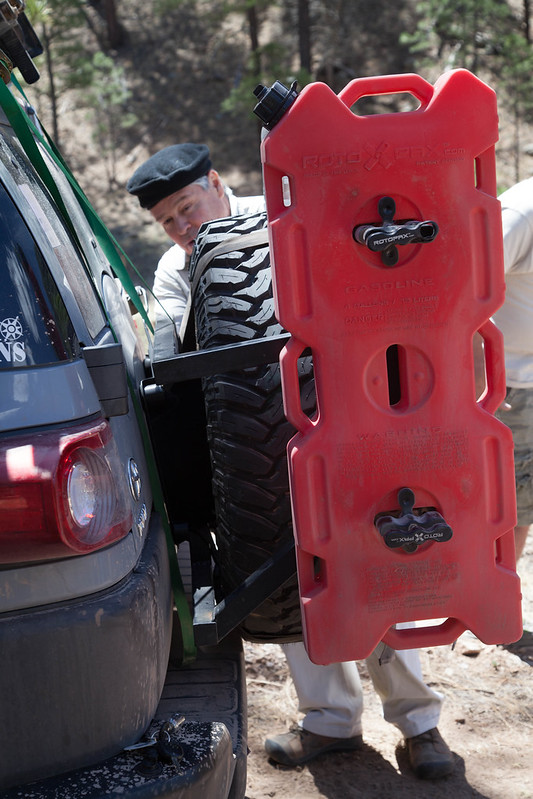
Sterling Noren’s clever Chevrolet conversion kept up effortlessly with all the more technologically advanced and prepared four-wheel-drive vehicles, and survived numerous blasts of speed as he raced ahead of the main group to film. But late in the trip, and late each day, the vehicle began dying at random and refusing to move more than a few feet unless it was allowed to cool for an hour or so. No codes showed on the OBD reader, and standard diagnostic investigation was futile, so Sterling simply let the van have a nap when needed.
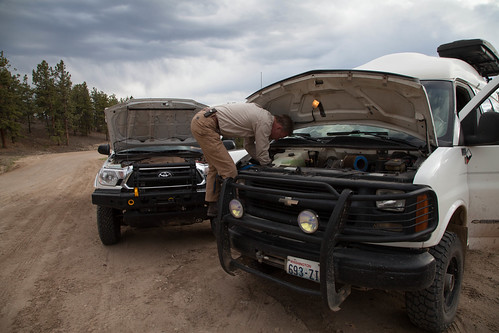
Both Raptors performed flawlessly, as did both Tacomas. Ross Blair's Tacoma benefitted from conscientious daily checks.
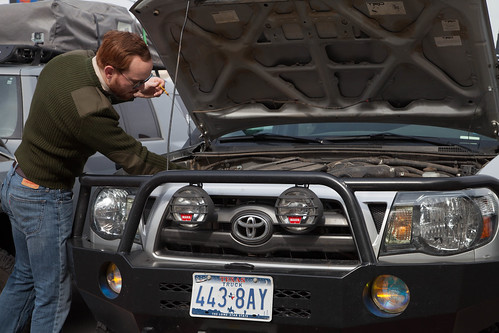
And that 1990 Bronco? It survived the trip in style as well.

On a related note, both Four Wheel Campers performed as they always do, providing a home away from home with a two-minute setup time, and scarcely affecting the backcountry abilities of the vehicles to which they're attached. With that said, the turnbuckle attachment system continues to require frequent checking; I'm determined to come up with a way to solidly anchor them. And, for the second time on ours, a silly strip of rubber trim around the front overhang came loose on a windy stretch of interstate, making a noise all out of proportion to its importance. Quibbles on a superb product, but needing attention.
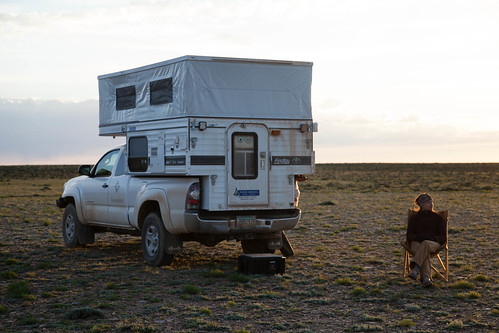
Other tidbits: Phil, who was towing an enclosed cargo trailer along a very muddy track in our wake on one of the easy sections, looked in his mirrors to note both fenders so loaded with sludge that they were ripping free of the trailer. He unbolted both and tossed them in the bed.
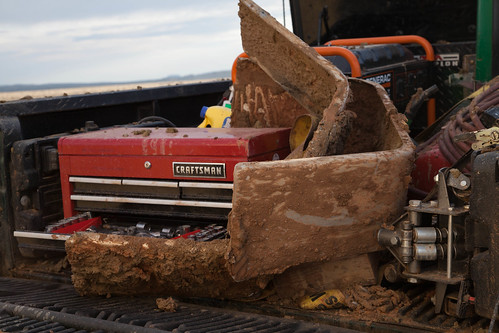
At one point I took over driving a two-wheel-drive support van shod with street tires along a level but treacherously slick muddy section, amusing the following drivers with the yaw angles I achieved while trying to keep the thing on the road. Luck was with me and I avoided ditching it. Total number of vehicle recoveries was remarkably low at three.
Oh, and, regarding Phil and the marshmallows? He proved remarkably apt at toasting them for s'mores with his oxy-acetylene torch.
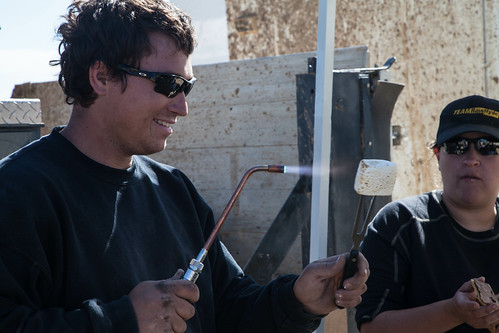
Update
on 2014-06-12 00:52 by Jonathan Hanson
An update: Michael Collier, the owner of one of the Sportsmobiles that suffered a water leak, reports that the source in his was a connection between the water pump and the lower water tank. These connections have large knurled fittings that are designed to be hand-tightened. Once snugged, Michael says, the system has remained secure. The long-term solution seems to be regular checks while attending to basic daily maintenance.
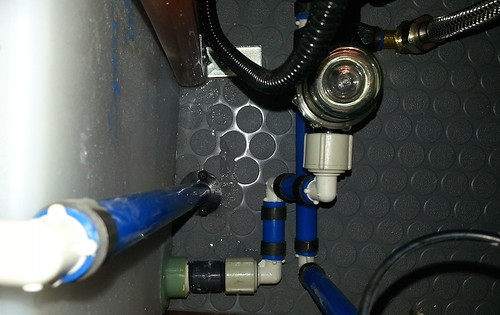
Accessible wonders

Many years ago, while on an assignment for Outside magazine, I was graced with the incomparable experience of viewing Victoria Falls for the first time by walking up to the edge of the drop on Livingstone Island, right in the middle of the mile-wide cascade, after arriving by canoe, just as David Livingstone had almost exactly 150 years before. The breath literally left me; I gasped and very nearly wept at the sight. Only the terror of totally losing my cool in front of my guide kept me halfway composed.
Much more recently—last week in fact—I was graced with another first: driving out of the tunnel on California State Highway 41, the Wawona Road, and seeing Yosemite Valley spread out before me below sweeping clouds and mist. El Capitan rose on the left in an impossible vertical wall; Bridalveil Fall plunged in a gossamer thread on the right.
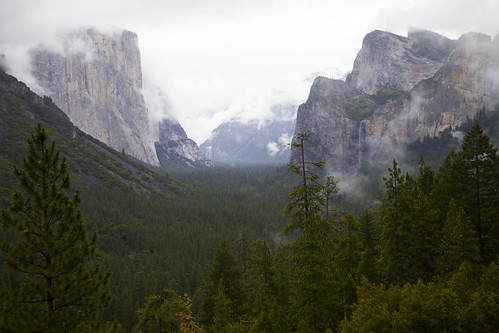
To paraphrase: The breath literally left me; I gasped and very nearly wept at the sight. Only the terror of totally losing my cool in front of my wife kept me halfway composed.
It was a good lesson in something many of us tend to forget: You don’t necessarily need to travel to Zambia (or fill in the blank) to have a once-in-a-lifetime experience. We were two easy day’s drive from home, and the sum total of our off-pavement excursions to that point had been about 500 yards of dirt road to reach a Forest Service dispersed campsite. Yet that view of Yosemite Valley will forever live in my memory directly alongside that first vertiginous peek over Victoria Falls.
The two natural wonders share more than you might think. Both were “discovered”—i.e. sighted for the first time by a person of European stock—in the mid-1800s, after of course being well-known to the locals for ages. In both cases, the “discoverers” were on profit-driven missions: Joseph Walker was looking for furs when he stumbled on Yosemite Valley, and Livingstone hoped to find a water route into the heart of the African continent. Both sites are now overrun with tourists pursuing, at times, tangent activities that seem utterly superfluous to me: I’ve said frequently that if you view Victoria Falls for the first time and think, Okay, cool—now I need to go bungee jumping off the bridge, then there’s something seriously wrong with your sense of wonder.
Yet the grandeur of both places effortlessly transcends the swarms of humans buzzing around them. Even at Yosemite, we found a trail along the Merced River, under El Capitan, on which in four miles we met two other people. And at Victoria Falls I spent a night camped on Livingstone Island (alone except for an askari), and got up at midnight to see the “moonbow”—a rainbow caused by moonlight shining through the mist of the falling water. Later I was awakened by the sound of foraging elephants, which wade to the island at night to feed.
So maybe I shouldn’t complain that everyone else was off bungee jumping.
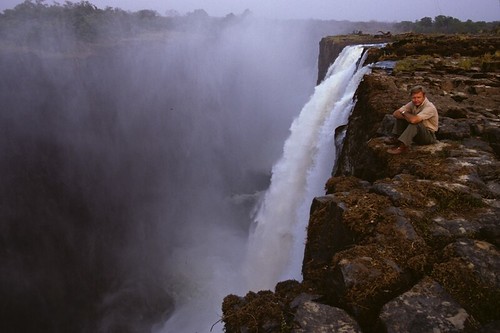 The author, alone at dusk on Livingstone Island. The bungee jumpers are off toasting their adventure somewhere.
The author, alone at dusk on Livingstone Island. The bungee jumpers are off toasting their adventure somewhere.
Three days on El Camino del Diablo
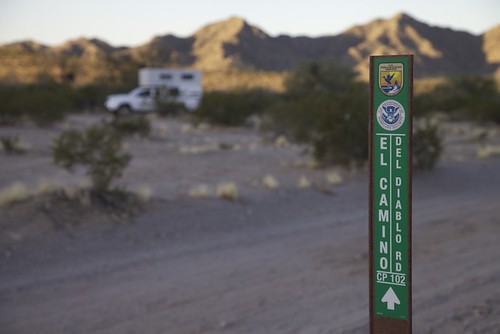
Few places on earth have experienced such a completely circular human history as the desert traversed by southern Arizona’s El Camino del Diablo. In the 17th, 18th, and 19th centuries its harsh plains and jagged mountains comprised a gauntlet for missionaries, explorers, and seekers of gold traveling northwest from Caborca to the first sure water at the Colorado River. In the late 20th and early 21st centuries it became another gauntlet, this time for illegal immigrants from Mexico and Central America trekking north seeking the gold of employment in the U.S. The tally of deaths from either period is impossible to pin down, but likely very similar. Some say each is in the hundreds.
Yet like many landscapes that have witnessed human tragedy, the magnificence of this corner of the Sonoran Desert transcends the strivings and failings of the bipedal creatures that scratch its surface. Here is a region where temperatures in summer regularly exceed 115 degrees Fahrenheit, yet where biological diversity is higher than in the pine-clad Rocky Mountains. Here lives a species of fish—found in just one spring-fed pond—that can survive water temperatures of 95 degrees and salinity higher than the ocean. The bighorn sheep that look down from the cliffs can lose 30 percent of their body weight to dehydration and survive with no ill effects. Within multi-holed mounds on the desert floor is a small rodent, the kangaroo rat, that never drinks or even needs to eat moist vegetation. It manufactures its own water from the carbohydrates in the dry seeds that comprise its entire diet. When winter rains are plentiful—meaning a few inches—the desert floor explodes in spring with a show of wildflowers to rival any English meadow. And always, always, the open space gives new room to lungs constricted by city living, and sharper vision to eyes clouded by concrete horizons.
I first traversed "The Road of the Devil" in the sultry August of 1979, alone in my FJ40. In a week I saw not another soul—as far as I know, I had a million acres all to myself. That has changed, and although the Cabeza Prieta National Wildlife Refuge and the Barry Goldwater Air force Range, through which the road passes, remain remote and rugged, the U.S. Border Patrol now maintains a persistent presence, with two F.O.B.s (forward operating bases) plonked down surreally in the desert, and constant patrols. Before you can get a permit as a new visitor, you’re required to watch a 15-minute video and sign off on a hold-harmless form detailing at least 27 ways a stupid person could get hurt or be blown to smithereens in the area.
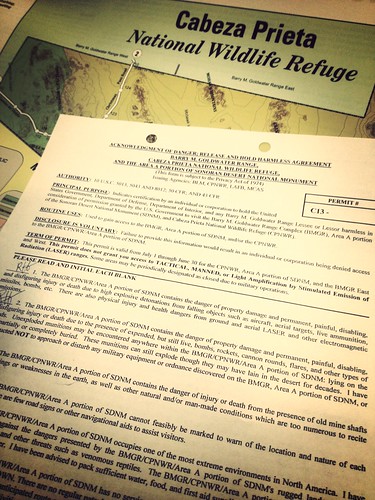
It’s worth it. The landscape along the main road from Ajo south and west through a corner of the Organ Pipe Cactus National Monument, across the Growler and Mohawk Valleys and the Tule Desert, is breathtaking, and changes with each pass through the mountain ranges—some dark, some light, some weirdly striped—that angle northwest/southeast through the refuge. The soft peach Pinta Sands dunes stand out in contrast to the surrounding lava fields, and improbable stretches of tightly overhanging mesquite trees mark the courses of washes that turn the road into impassible muck during summer thunderstorms.
The entire center section of the Camino is closed to public use from March 15 to July 15 to minimize disturbance to the secretive and endangered Sonoran pronghorn during fawning season—although the impact of the Border Patrol and migrants must be far greater than that of the few tourists who still brave the route. But if you wish, you can still drive in to the spectacular Tinajas Altas tanks from the west.
We beat the closure and spent a too-short weekend driving from Ajo to Tule Well, then north through Christmas Pass to Interstate 8. While some parts of the road are rough, and there are miles of corrugations north of Christmas Pass, we could have done the trip easily in a two-wheel-drive truck—or a sedan—in these conditions. West of Tule there are sections of bulldust that would challenge a low-clearance vehicle, however.
 A four-wheel-drive Tacoma is almost overkill on El Camino. We're doing our best to abuse the stock street tires that came with the truck before mounting some all-terrain rubber.
A four-wheel-drive Tacoma is almost overkill on El Camino. We're doing our best to abuse the stock street tires that came with the truck before mounting some all-terrain rubber.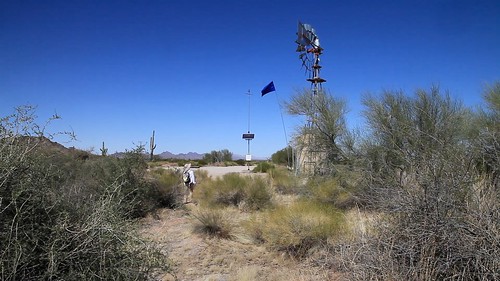 Our first camp was at Papago Well, where a relief station and emergency beacon set up for migrants is marked with a blue flag.
Our first camp was at Papago Well, where a relief station and emergency beacon set up for migrants is marked with a blue flag. 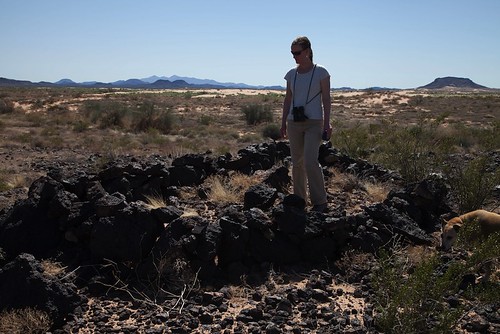 Marisa stands amid the Pinacate lava flow, the northernmost extension of the Pinacate volcanic region. Near here is also the northernmost extension of the Altar dune field, called the Pinta Sands.
Marisa stands amid the Pinacate lava flow, the northernmost extension of the Pinacate volcanic region. Near here is also the northernmost extension of the Altar dune field, called the Pinta Sands.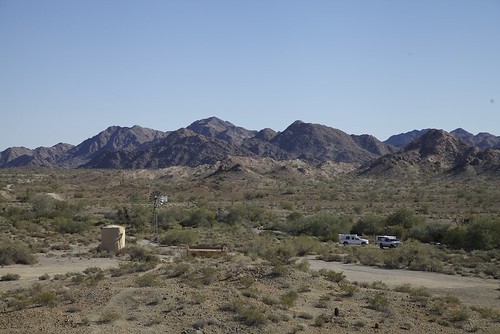 Looking down on Tule Well and the campsite (one of four on the refuge). The little cabin was built in 1989, replacing an earlier structure. A log book is inside for visitors to sign.
Looking down on Tule Well and the campsite (one of four on the refuge). The little cabin was built in 1989, replacing an earlier structure. A log book is inside for visitors to sign.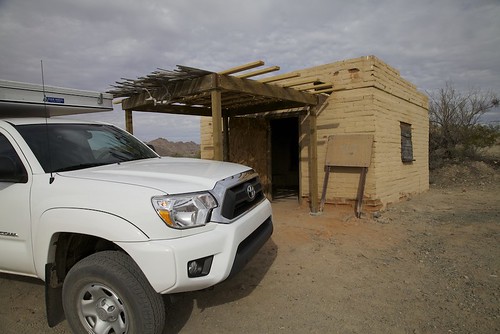 Tule cabin is open and available for anyone to use if needed. There's even a small fireplace in the corner.
Tule cabin is open and available for anyone to use if needed. There's even a small fireplace in the corner.
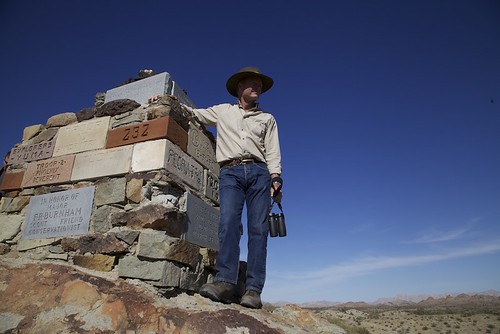 Boy Scout troops erected this monument on the hill overlooking tule Well.
Boy Scout troops erected this monument on the hill overlooking tule Well.
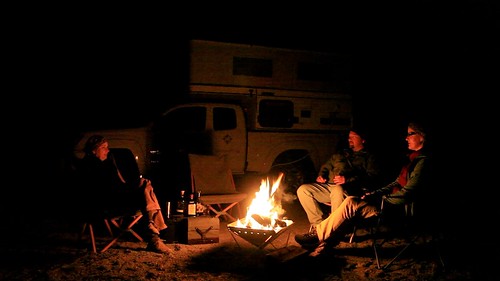 Campfires are permitted, but you must bring your own wood. We also used a sturdy Snow Peak Pack & Carry fireplace.
Campfires are permitted, but you must bring your own wood. We also used a sturdy Snow Peak Pack & Carry fireplace.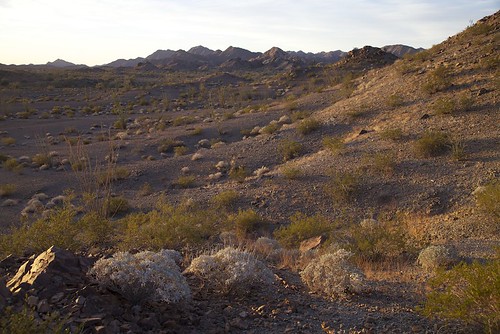 Dawn from Tule Camp. Mockingbirds and Phainopeplas were getting ready to breed, and singing.
Dawn from Tule Camp. Mockingbirds and Phainopeplas were getting ready to breed, and singing.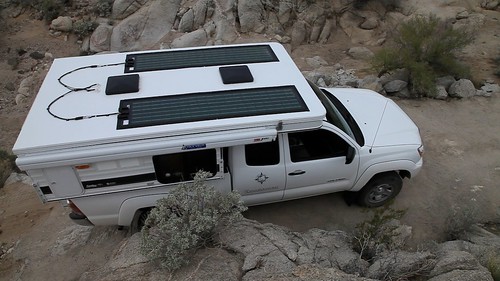 Heading north through Christmas Pass, affording a fine view of our ultra-low-profile Global Solar photovoltaic panels, which provide the Four Wheel Camper with a surfeit of power.
Heading north through Christmas Pass, affording a fine view of our ultra-low-profile Global Solar photovoltaic panels, which provide the Four Wheel Camper with a surfeit of power.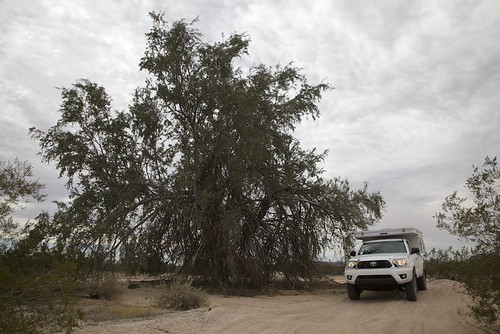 Under a cloudy sky we headed north toward I-8, past this enormous ironwood tree.
Under a cloudy sky we headed north toward I-8, past this enormous ironwood tree.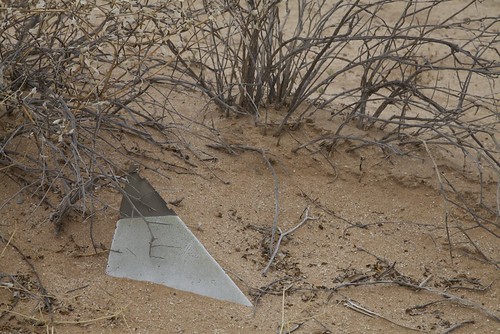 Lots of unexploded ordnance on the Barry M. Goldwater range. This fin could be a piece, or there could be an entire missile under there. Do we pull on it?
Lots of unexploded ordnance on the Barry M. Goldwater range. This fin could be a piece, or there could be an entire missile under there. Do we pull on it? Federal law states that it illegal to visit the Cabeza Prieta without stopping at Dateland afterwards for a zillion-calorie date shake. Well, if it's not illegal, it should be. Support local business!
Federal law states that it illegal to visit the Cabeza Prieta without stopping at Dateland afterwards for a zillion-calorie date shake. Well, if it's not illegal, it should be. Support local business!
If you go: The refuge headquarters and visitors' center is in Ajo, on the road north out of (or into) town (Monday through Friday 8:00 to 4:00). You're required to obtain a free permit to enter the refuge, and will also need to register at a kiosk on the refuge border. The roads through the refuge are easily traversed, but a sturdy vehicle is recommended. You could drive the length in a day if you really wanted to, but it would be a wasted journey not to slow down and experience the scenery and wildlife.
Take plenty of water—there are no reliable sources on the refuge, and what's there is needed for wildlife. Take enough to ensure you could walk out to the nearest highway if necessary; don't count on a Border Patrol agent coming along to rescue you.
A fine book on the Camino del Diablo is Sunshot, by Bill Broyles.
View our entire collection of trip photos on Flickr, here, and our video highlights, below.
Hint: When using “Search,” if nothing comes up, reload the page, this usually works. Also, our “Comment” button is on strike thanks to Squarespace, which is proving to be difficult to use! Please email me with comments!
Overland Tech & Travel brings you in-depth overland equipment tests, reviews, news, travel tips, & stories from the best overlanding experts on the planet. Follow or subscribe (below) to keep up to date.
Have a question for Jonathan? Send him an email [click here].
SUBSCRIBE
CLICK HERE to subscribe to Jonathan’s email list; we send once or twice a month, usually Sunday morning for your weekend reading pleasure.
Overland Tech and Travel is curated by Jonathan Hanson, co-founder and former co-owner of the Overland Expo. Jonathan segued from a misspent youth almost directly into a misspent adulthood, cleverly sidestepping any chance of a normal career track or a secure retirement by becoming a freelance writer, working for Outside, National Geographic Adventure, and nearly two dozen other publications. He co-founded Overland Journal in 2007 and was its executive editor until 2011, when he left and sold his shares in the company. His travels encompass explorations on land and sea on six continents, by foot, bicycle, sea kayak, motorcycle, and four-wheel-drive vehicle. He has published a dozen books, several with his wife, Roseann Hanson, gaining several obscure non-cash awards along the way, and is the co-author of the fourth edition of Tom Sheppard's overlanding bible, the Vehicle-dependent Expedition Guide.













